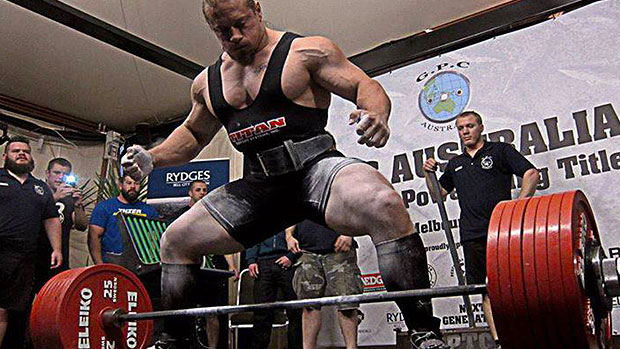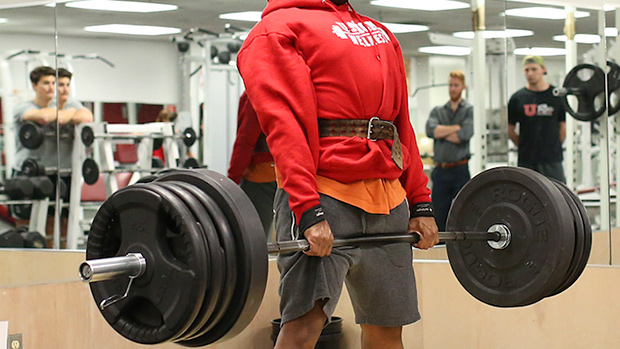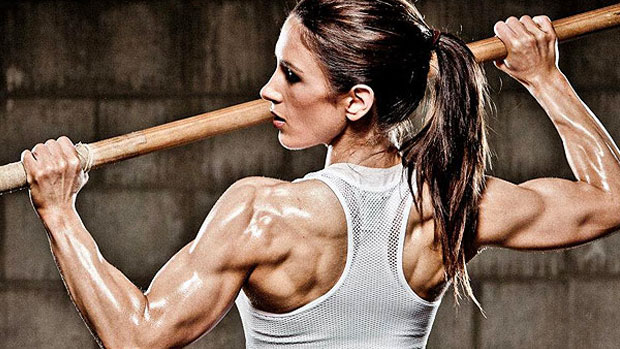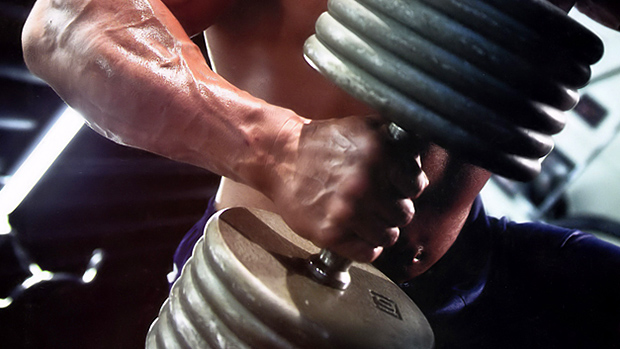Here's what you need to know...
- To build the deadlift, prioritize the squat for 6 weeks while not pulling heavy at all.
- Powerlifter Dan Green's number one deadlift tip is to regularly perform the stiff-leg deadlift.
- Mike Tuchscherer recommends building the deadlift by pausing at the bottom of the lift, around an inch or two off the ground.
- For many lifters, deadlift strength is limited by what they can hold. Strengthen your grip to pull more.
- Konstantin Konstantinovs builds grip strength by holding the top position during the last rep of the heaviest set of deadlifts.
- Tom Martin recommends improving the deadlift by setting up so your hips are in the same position they'll be in when the bar actually leaves the ground.
1 – At Times, Prioritize the Squat
This may seem counterintuitive, but the squat keeps your deadlift in check. If you only deadlifted and never squatted, your hips would eventually shoot up and your deadlift would become too hip dominant.
Your quads need to be very strong in a deadlift as they obviously help you drive with the legs, initiate the pull with a lower hip position, prevent the torso from being too horizontal at lift-off, and prevent excessive rounding.
For six weeks, try squatting heavy three times per week. During this time, don't deadlift heavy at all. Instead, do dynamic effort (speed) pulls with 60-80% of 1RM for 3 sets of 1-3 reps.
Think this strategy sounds absurd? Think again. Many powerlifters find that after following intensive squatting protocols such as Smolov or The Russian Squat Routine, their deadlift strength increases.
But don't rely on this strategy year round. If you want to maximize your deadlift strength, you'll definitely have to push the deadlift at strategic points throughout the year.

2 – Utilize Variety
Talk to 100 powerlifters about their favorite deadlift assistance exercises and you'll get 100 different answers. Every lifter has particular weaknesses that can be strengthened through different assistance lifts.
For example, some lifters are markedly stronger on rack or block pulls than they are from the floor, while other lifters are actually weaker when pulling off of 3-4 inch blocks. Lifters who are weaker from a shortened range of motion tend to get more out of partials than lifters who are stronger with partials.
Here are some of the exercises that you'll typically hear strong lifters credit for helping them build their deadlift:
- Front squat, low box squat, safety bar squat, Bulgarian split squat, leg press
- Deficit deadlift, block pull, stiff-leg deadlift, pause deadlift, Dimel deadlift
- Good morning, cambered bar good morning, safety-squat bar good morning
- Barbell hip thrust, single-leg hip thrust, barbell glute bridge
- Glute ham raise, back extension, reverse hyper, kettlebell swing, pull through
Experiment with these exercises to figure out what works best for you. In addition, make sure to utilize a variety of rep ranges. I asked powerlifter Dan Green for his number one deadlift-building tip and he recommends that you regularly perform the stiff-leg deadlift.
Dan does them while standing on a 4-inch block for added hip range of motion and his best lift for the stiff-leg deadlift is 615 pounds x 6 reps.
3 – Utilize Specificity
This tip contradicts the first two, but don't get hung up on that. While the first two tips recommended relying on squats and variety to build your deadlift, this tip recommends ultra-specificity.
For a six week period, pull heavy twice per week:
- Spend two weeks doing 3 sets of deadlifts for 5 reps.
- Then spend two weeks doing 3 sets of deadlifts for 3 reps.
- Followed by two weeks doing 3 sets of deadlifts for 1 rep.
During this time, don't squat heavy at all. Do dynamic effort (speed) squats with 60-80% of 1RM for 3 sets of 3 reps.
4 – Master the Opposite Stance
If you pull sumo, focus on building up your conventional strength for a couple of months. If you pull conventional, spend a couple of months building up your sumo strength.
The two styles can feed off of each other, and you don't want a huge imbalance between conventional and sumo deadlift strength anyhow. In addition, you should incorporate the semi-sumo stance (medium width) deadlift from time to time.
5 – Perform Pause Deadlifts
Pause reps are the weapon of choice for top powerlifter Mike Tuchscherer. He pauses at the bottom of the lift, around an inch or two off the ground. However, you can pause anywhere you'd like, like right below the knees or right above the knees. You can also pause twice throughout the ROM.
Pause deadlifts require discipline since it's quite uncomfortable and challenging to hold proper positioning while pausing in the middle of a rep.

6 – Get Strong Off the Floor
You can never be too strong off the floor. The stronger your starting strength, the faster you'll be moving the bar through the sticking region, which will improve your chances of achieving lockout.
Moreover, the better you can hold proper position off the floor, the easier the lockout will be.
What seems to improve deadlift strength off the floor varies from one lifter to another, but some options include dynamic effort deadlifts, pause deadlifts, deficit deadlifts, snatch-grip deadlifts, back squats, front squats, Bulgarian split squats, and leg presses.
7 – Increase Lockout Strength
You won't always pull the bar off the ground in perfect position, and your bar path won't always be solid, either. In these situations, the lockout will be markedly harder to achieve.
Moreover, when maxing out, a large percentage of lifters will find that their spinal position buckles slightly prior to liftoff, thus making the lockout harder to achieve. So, you'll want your lockout strength to be as strong as possible.
What improves deadlift lockout strength varies from one lifter to another, but some options include banded deadlifts, chain deadlifts, American deadlifts, block pulls, barbell hip thrusts, barbell glute bridges, and weighted back extensions.

8 – Strengthen Your Grip
Some lucky lifters naturally possess insanely strong grip strength. They never have to train their grip specifically. Their grip gets strong from doing deadlifts and performing upper-body work such as dumbbell exercises, shrugs, and chins.
Other lifters aren't so lucky. Their deadlift strength is limited by what they can hold. When they use straps they're markedly stronger, and due to their poor grip strength, their muscles seem to shut down – the hip and knee extensors just won't maximally activate.
Strengthening the grip will improve confidence, increase muscle activation throughout the entire body, and allow for greater acceleration off the floor.
Perform any of the following exercises to strengthen your grip: farmer's walks, Kroc rows, static hangs, static barbell holds, shrugs with a double overhand grip, bent-over rows with a double overhand grip, bench squeezes, and/or grippers.
Another option is to simply hold the top position for extended time during the last rep of your heaviest set of deadlifts. Powerlifter Konstantin Konstantinovs likes to do this, and clearly it works for him.
9 – Focus on Technique
You may have heard that in order to improve your deadlift, you need to strengthen a particular muscle such as your glutes, quads, hamstrings, or erectors. But you may find that you get more out of working on technique rather than performing isolation/targeted movements for a particular muscle.
For example, powerlifter Chris Duffin provides the following advice: "If you're asking yourself whether you need to build a stronger low back to improve your deadlift, you need to look instead to your technique."
In other words, rather than performing various spinal extension or targeted back movements, just work on pulling with a solid arch over and over until it becomes automatic.
The muscles will eventually get strong at the proper lengths, and the nervous system will memorize the motor pattern. This strategy requires patience and consistency, but it pays dividends over time.
Likewise, make sure the bar skims your legs during the deadlift – it should never be more than an inch away from the shins or the thighs throughout the entire concentric and eccentric range of motion.
Another excellent piece of advice comes from powerlifter Tom Martin:
"Don't try to pull from an overly optimistic start position. Set up so that your hips are in the same position they will be in when the bar actually leaves the ground. If you set up with your hips so low that they shoot up 10" before the weight actually moves, you will a) be pulled into a position you didn't get tight in, and b) lose a lot of speed off the floor."





